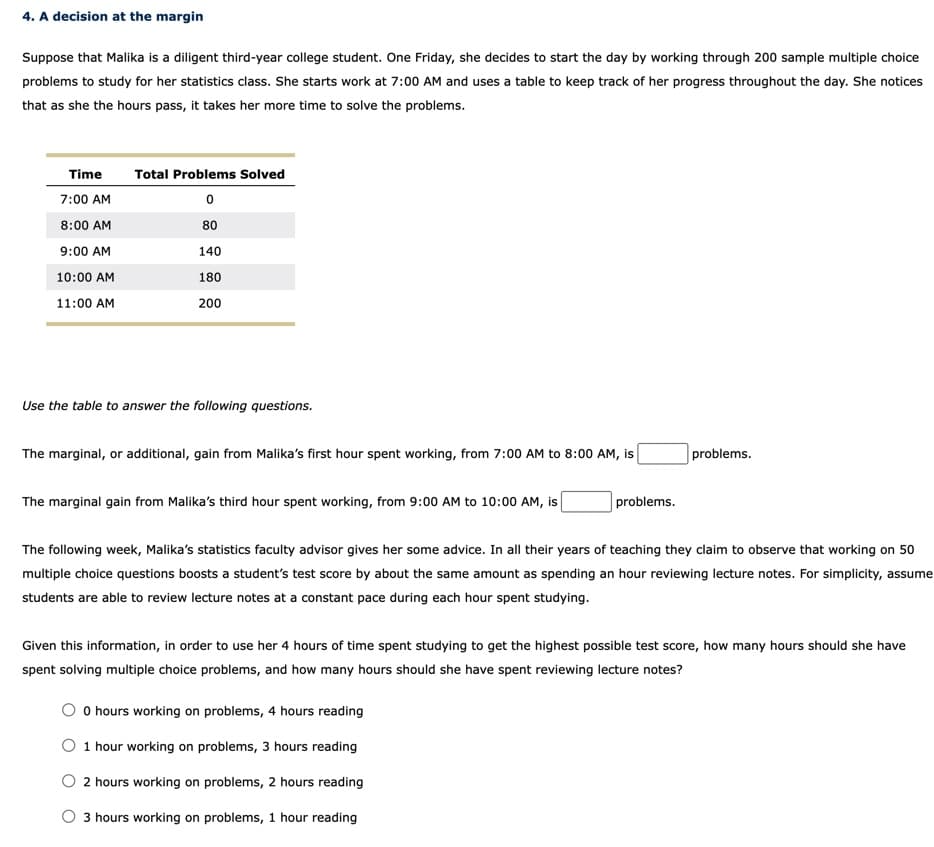Suppose that Malika is a diligent third-year college student. One Friday, she decides to start the day by working through 200 sample multiple choice problems to study for her statistics class. She starts work at 7:00 AM and uses a table to keep track of her progress throughout the day. She notices that as she the hours pass, it takes her more time to solve the problems. Time 7:00 AM 8:00 AM 9:00 AM 10:00 AM 11:00 AM Total Problems Solved 0 80 140 180 200 Use the table to answer the following questions. The marginal, or additional, gain from Malika's first hour spent working, from 7:00 AM to 8:00 AM, is The marginal gain from Malika's third hour spent working, from 9:00 AM to 10:00 AM, is problems. problems. The following week, Malika's statistics faculty advisor gives her some advice. In all their years of teaching they claim to observe that working on 50 multiple choice questions boosts a student's test score by about the same amount as spending an hour reviewing lecture notes. For simplicity, assume students are able to review lecture notes at a constant pace during each hour spent studying. 0 hours working on problems, 4 hours reading O 1 hour working on problems, 3 hours reading 2 hours working on problems, 2 hours reading O 3 hours working on problems, 1 hour reading Given this information, in order to use her 4 hours of time spent studying to get the highest possible test score, how many hours should she have spent solving multiple choice problems, and how many hours should she have spent reviewing lecture notes?
Suppose that Malika is a diligent third-year college student. One Friday, she decides to start the day by working through 200 sample multiple choice problems to study for her statistics class. She starts work at 7:00 AM and uses a table to keep track of her progress throughout the day. She notices that as she the hours pass, it takes her more time to solve the problems. Time 7:00 AM 8:00 AM 9:00 AM 10:00 AM 11:00 AM Total Problems Solved 0 80 140 180 200 Use the table to answer the following questions. The marginal, or additional, gain from Malika's first hour spent working, from 7:00 AM to 8:00 AM, is The marginal gain from Malika's third hour spent working, from 9:00 AM to 10:00 AM, is problems. problems. The following week, Malika's statistics faculty advisor gives her some advice. In all their years of teaching they claim to observe that working on 50 multiple choice questions boosts a student's test score by about the same amount as spending an hour reviewing lecture notes. For simplicity, assume students are able to review lecture notes at a constant pace during each hour spent studying. 0 hours working on problems, 4 hours reading O 1 hour working on problems, 3 hours reading 2 hours working on problems, 2 hours reading O 3 hours working on problems, 1 hour reading Given this information, in order to use her 4 hours of time spent studying to get the highest possible test score, how many hours should she have spent solving multiple choice problems, and how many hours should she have spent reviewing lecture notes?
Chapter1: Introducing The Economic Way Of Thinking
Section1.A: Applying Graphs To Economics
Problem 2SQP
Related questions
Question
Sub : Economics
Pls answer very fast.I ll upvote correct answer. Thank You

Transcribed Image Text:4. A decision at the margin
Suppose that Malika is a diligent third-year college student. One Friday, she decides to start the day by working through 200 sample multiple choice
problems to study for her statistics class. She starts work at 7:00 AM and uses a table to keep track of her progress throughout the day. She notices
that as she the hours pass, it takes her more time to solve the problems.
Time
7:00 AM
8:00 AM
9:00 AM
10:00 AM
11:00 AM
Total Problems Solved
0
80
140
180
200
Use the table to answer the following questions.
The marginal, or additional, gain from Malika's first hour spent working, from 7:00 AM to 8:00 AM, is
The marginal gain from Malika's third hour spent working, from 9:00 AM to 10:00 AM, is
problems.
problems.
The following week, Malika's statistics faculty advisor gives her some advice. In all their years of teaching they claim to observe that working on 50
multiple choice questions boosts a student's test score by about the same amount as spending an hour reviewing lecture notes. For simplicity, assume
students are able to review lecture notes at a constant pace during each hour spent studying.
0 hours working on problems, 4 hours reading
O 1 hour working on problems, 3 hours reading
2 hours working on problems, 2 hours reading
O 3 hours working on problems, 1 hour reading
Given this information, in order to use her 4 hours of time spent studying to get the highest possible test score, how many hours should she have
spent solving multiple choice problems, and how many hours should she have spent reviewing lecture notes?
Expert Solution
This question has been solved!
Explore an expertly crafted, step-by-step solution for a thorough understanding of key concepts.
This is a popular solution!
Trending now
This is a popular solution!
Step by step
Solved in 4 steps

Knowledge Booster
Learn more about
Need a deep-dive on the concept behind this application? Look no further. Learn more about this topic, economics and related others by exploring similar questions and additional content below.Recommended textbooks for you








